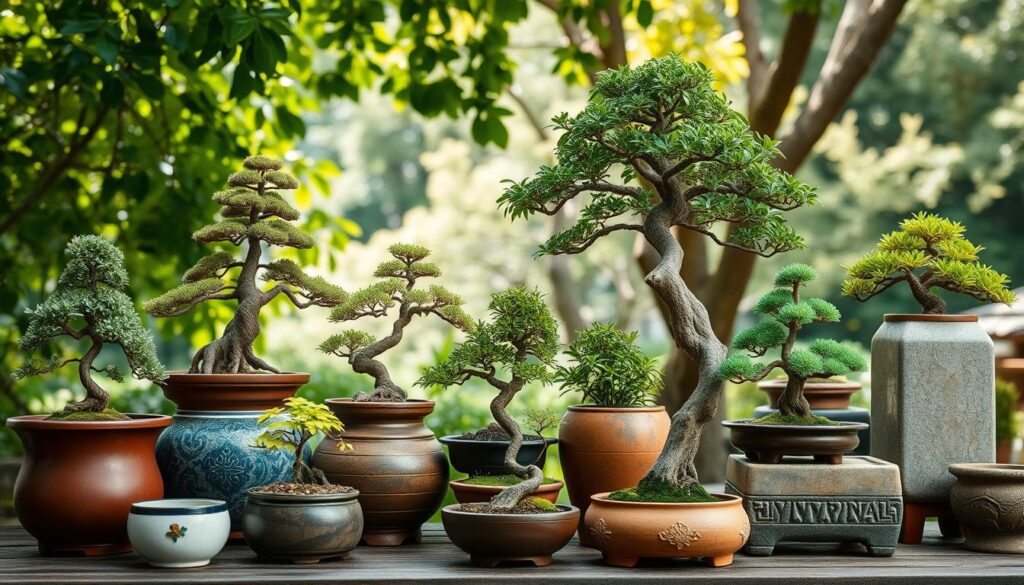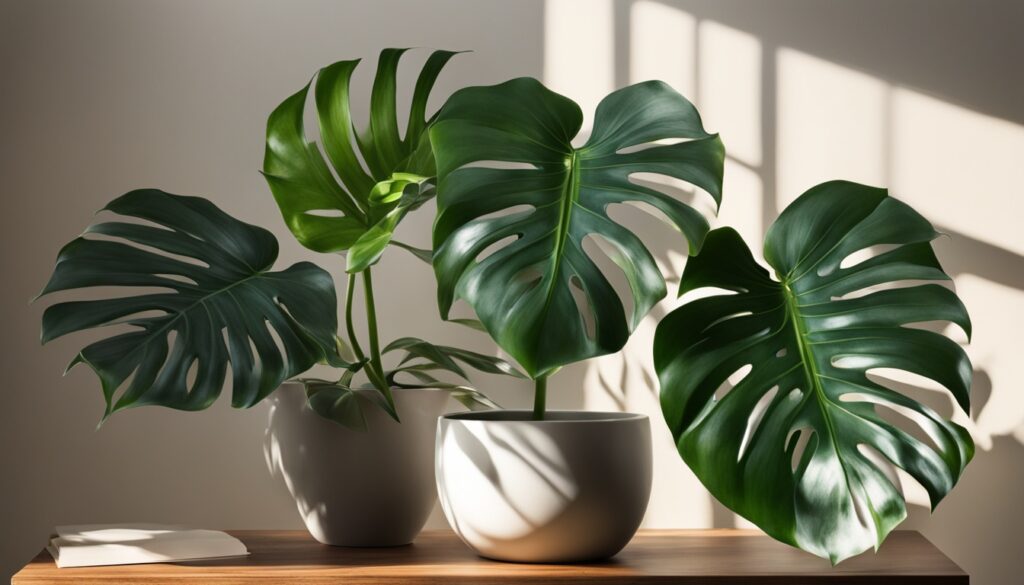Are you ready to take your bonsai artistry to new heights? The key to showcasing your miniature masterpieces with elegance and style lies in the perfect bonsai pot. But with so many options available, how do you choose the ideal container that will nourish your trees and captivate your audience? Prepare to embark on a journey of discovery as we unveil the top 10 best pots for bonsai in.
Key Takeaways
- Proper drainage is essential for healthy bonsai roots and preventing waterlogging
- Pot weight and stability play a crucial role in keeping your bonsai tree upright and secure
- The right pot size allows for optimal root growth and development over time
- Pot material, such as unglazed clay or glazed ceramics, can impact your bonsai’s climate adaptation
- Aesthetic harmony between the bonsai tree and its container is key for a visually stunning display
Understanding the Importance of Bonsai Pots in Tree Development
Bonsai pots are more than just homes for these tiny trees. They are key to the trees’ health and growth. The type of bonsai pot and its size greatly affect the tree’s growth, stability, and look.
Role of Pots in Bonsai Health
The bonsai pot’s material impacts how well the tree breathes and gets moisture. Terracotta pots, being porous, let air and water through better. Plastic pots, however, can harm the roots and slow growth. It’s also vital to prevent waterlogged roots, as they can cause disease and decay.
Relationship Between Pot and Tree Growth
The size of the bonsai pot affects how fast and big the tree grows. Bigger pots let the tree grow more, while smaller ones keep it small and neat. Finding the right pot size is key to the tree’s look and growth.
Impact on Root Development
Bonsai pots shape the tree’s roots. The pot’s size and material help the roots grow in a way that supports the tree. The wrong pot can cause the roots to grow unevenly, harming the tree’s health and look.
“The choice of bonsai pot is not just an aesthetic decision – it’s a critical factor in the long-term health and development of the tree.”
Knowing how bonsai pots affect tree growth is essential for growing beautiful bonsai trees. By picking the right materials, sizes, and shapes, bonsai lovers can help their trees reach their full potential.
Essential Features of Quality Bonsai Containers
Choosing the right container is key for your bonsai tree’s health and growth. Quality bonsai pots need to have a few important features. One key feature is draining bonsai pots to avoid waterlogging, which harms the roots.
The pot’s weight is also crucial for stability, especially for heavy bonsai trees. The container’s size is important too, allowing for growth without over-potting. The material of the pot matters, considering its porosity and how it adapts to the climate.
- Unglazed clay pots are great for air and water exchange, loved by many bonsai fans.
- Glazed ceramic pots keep moisture better, fitting some bonsai species and climates well.
Choosing a quality bonsai container is about finding a balance between practical and beautiful aspects. This ensures your bonsai tree stays healthy and looks great for years.
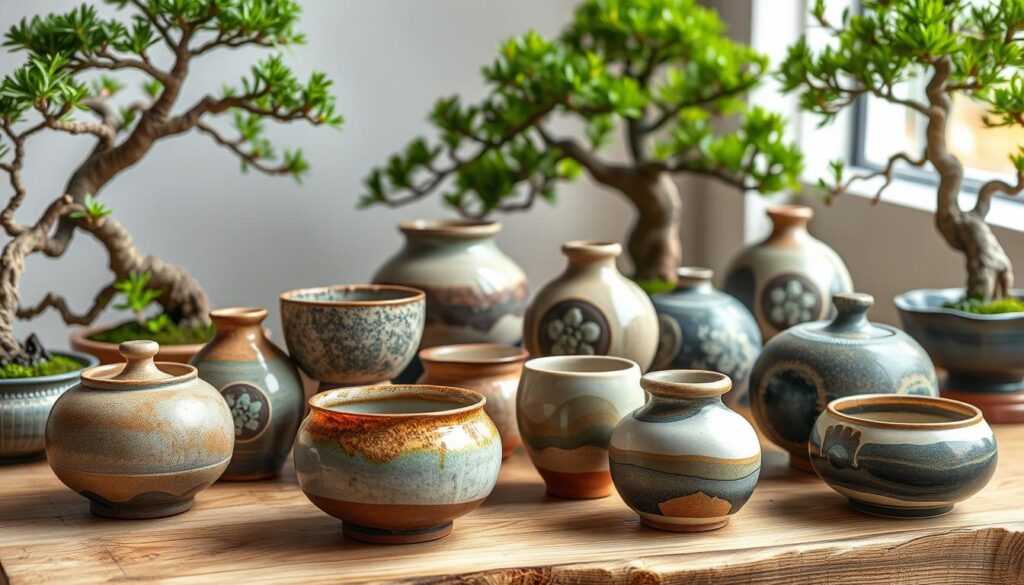
“The pot is the soul of the bonsai.” – John Naka, renowned bonsai master
Factors to Consider in Choosing Bonsai Pots
- Adequate drainage holes
- Stable and sturdy construction
- Appropriate size for the bonsai tree
- Porosity and climate adaptability
- Aesthetically pleasing design
Understanding the essential features of quality bonsai containers helps you make a good choice. This choice supports your bonsai tree’s growth and beauty for years to come.
Best Pots for Bonsai: Top Selections for 2024
The art of bonsai is growing in popularity around the world. Choosing the right pot is key to growing these tiny trees. In 2024, [a href=”https://bonsaitree-care.com/types-of-bonsai-trees-indoor/”]indoor bonsai species[/a] like Ficus, Dwarf Jade, and Fukien Tea will do well in many pots. These include premium ceramic, budget-friendly, and professional-grade options.
Premium Ceramic Options
High-fired stoneware and porcelain pots are known for their durability and beauty. They often have detailed designs and glazes that highlight the bonsai’s natural beauty. Prices for these pots can be high, from hundreds to thousands of dollars, based on the maker’s reputation and craftsmanship.
Budget-Friendly Choices
If you’re starting with bonsai on a budget, consider plastic [a href=”https://bonsaitree-care.com/bonsai-tree/”]Anderson flats[/a] or colanders. They’re affordable and help with air circulation and root growth. While not as fancy as ceramic pots, they can still help your bonsai thrive.
Professional Grade Selections
For those serious about bonsai, custom-made wooden boxes or specialized ceramic pots are ideal. These pots are made with great care, ensuring a perfect fit for your bonsai. They can cost a lot, from hundreds to thousands of dollars, showing the skill in their making.
| Pot Type | Typical Price Range | Key Features |
|---|---|---|
| Premium Ceramic | $100 to $1,000+ | Exceptional durability, aesthetic appeal, and intricate designs |
| Budget-Friendly | $20 to $100 | Cost-effective solution, promote air circulation and root health |
| Professional Grade | $500 to $5,000+ | Custom-made for specific bonsai styles or species, showcasing exceptional craftsmanship |
Whether you’re new or experienced, the right bonsai pot is crucial. It affects your bonsai’s growth and health. By picking the right material, size, and look, you can enhance your bonsai’s beauty and potential.
Drainage Systems and Water Management
Drainage is key for bonsai tree care. Pots need holes at the bottom for water to drain. Use a mesh to keep soil in while letting water out. The pot’s material affects how it holds moisture.
Unglazed pots need more water because they’re more porous.
Knowing your bonsai’s water needs is vital. Some trees, like conifers, need more water to avoid die-back. But too much water can cause root rot. Look out for yellow leaves, wilting, or rotting roots.
- Recommended soil mixture for bonsai trees: akadama, pumice, and lava rock in a ratio of ½ to ¼ to ¼
- Ratio for soil mixture that retains more water: more akadama or compost can be used
- Type of watering can ideal for bonsai trees: one with a fine nozzle to prevent soil erosion
- Recommended depth to check soil moisture before watering: about one centimeter deep (0.4″)
Most water will drain out when you water, showing you need to repot. The pot size, soil, and environment affect how much water your bonsai needs. Good drainage and water management keep your bonsai healthy.
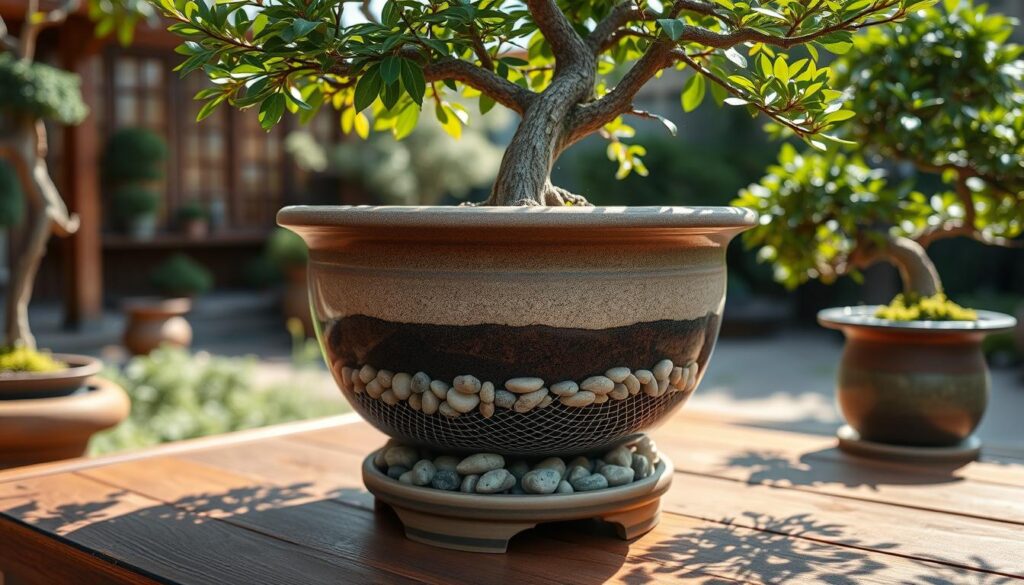
“Around 90% of issues faced by bonsai tree owners are generally related to watering problems.”
| Statistic | Value |
|---|---|
| It can take a full-time apprentice up to 3 years to master the essentials of watering techniques. | 3 years |
| Over-watering can lead to root rot due to lack of oxygen in the soil. | N/A |
| Different tree species have varied water requirements, emphasizing the importance of species-specific watering practices. | N/A |
| The composition of the growing medium influences watering frequency; organic materials hold water longer compared to inorganic substrates. | N/A |
Choosing the Right Pot Size for Your Bonsai
Finding the right pot size is key for your bonsai’s health and looks. A bigger pot means your bonsai can go longer without water. But, it’s all about finding that perfect balance for your bonsai to thrive.
Size-to-Tree Ratio Guidelines
The pot should be about two-thirds the height of your bonsai tree. This keeps the tree and pot looking balanced. Different trees need to be repotted at different times, from once a year to several years.
Depth Considerations
The pot’s depth should match the trunk’s thickness just above the soil. For a 1-inch trunk, a 6-8 inch long, 2-inch deep, and 4-5 inch wide pot is good.
Width and Length Calculations
The pot’s width should be a bit less than the longest branch spread. If the tree is wider than tall, the pot’s length should be two-thirds its width. Straight trunks do well in rectangular pots, while curved trunks look better in oval or round pots.
Choosing the right bonsai pot sizes is crucial for bonsai care. By following these tips, you can give your bonsai the support and beauty it needs.
| Pot Type | Recommended Bonsai Styles |
|---|---|
| Rectangular | Chokkan, Moyogi |
| Round | Informal, Cascading |
| Oval | Balanced, Versatile |
“The right pot can make all the difference in the health and appearance of your bonsai tree.”
Materials and Their Impact on Tree Health
Choosing the right pot material is key to keeping bonsai trees healthy. Bonsai pot materials like high-fired stoneware, earthenware, and porcelain each have their own benefits. They all play a big role in bonsai pot care.
Stoneware is tough and not very porous, making it good for many climates. Earthenware is more porous, helping roots breathe but can be damaged by frost. Porcelain is loved for its beauty, adding a sleek touch to bonsai displays.
| Pot Material | Key Characteristics | Suitability |
|---|---|---|
| Stoneware | Durable, less porous | Suitable for various climates |
| Earthenware | More porous, aeration benefits | Susceptible to frost damage |
| Porcelain | Aesthetic qualities | Suitable for indoor bonsai |
The type of bonsai pot you choose affects insulation, weight, and how much air gets in. This, in turn, changes how you care for your bonsai tree. Knowing what each material does is essential for your bonsai’s health and growth.
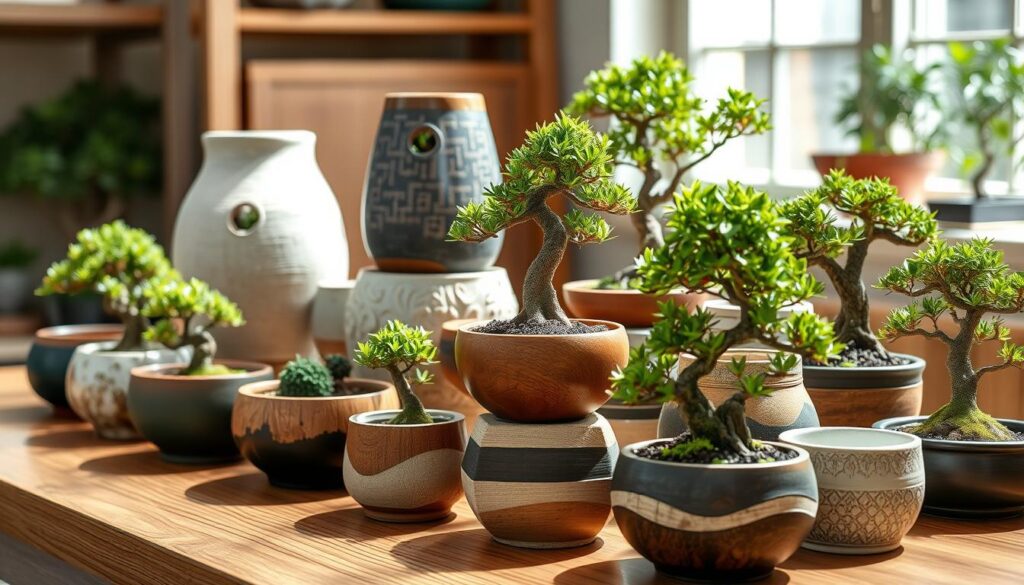
“The right pot can make all the difference in the health and development of a bonsai tree. Carefully selecting the material is a critical step in providing the optimal environment for your miniature wonder.”
Aesthetic Harmony: Matching Pots to Bonsai Styles
Choosing the right bonsai pot is more than just about function. It’s about finding harmony between the pot and the tree. The pot should match the tree’s form, color, and style, making a beautiful sight together.
Color Coordination Principles
The bonsai pot’s color should bring out the tree’s beauty without taking over. Earthy tones like browns and greys suit deciduous trees well. Neutral colors like white, black, and grey highlight evergreen trees’ natural beauty.
For a bold look, colors like red or blue can add excitement. But, the color should still fit the tree’s personality.
Shape and Style Compatibility
The pot’s shape should match the tree’s lines and shape. Rounded pots suit informal trees, while geometric pots fit formal ones. A ratio of 2/3 of the tree’s height is good for oval and rectangular pots. Round or square pots should be about 1/3 of the tree’s height, unless the foliage is big.
Traditional vs. Modern Designs
Choosing between traditional and modern pots affects the look. Traditional pots have classic shapes and cultural designs, showing a timeless beauty. Modern pots have clean lines and simple designs, offering a fresh take on bonsai art.
The right choice depends on the tree’s character and the look you want to achieve.
“The bonsai pot is not just a container; it’s an integral part of the overall artistic expression of the bonsai.”
By thinking about color, shape, and style, bonsai lovers can make a stunning display. This balance brings out the tree’s beauty and makes the bonsai more authentic.
Understanding Different Pot Materials
Choosing the right pot for your bonsai is key to its health and growth. Ceramic bonsai pots are a top choice for many enthusiasts. They offer several benefits.
Ceramic pots are made from clay fired at high temperatures. This makes them durable and long-lasting. They come in types like high-fired stoneware, earthenware, and porcelain. The glazing process adds a beautiful finish, from glossy to matte, letting you customize your bonsai’s look.
For a natural look, unglazed ceramic pots are great. They are porous, allowing for good air circulation and drainage. This is vital for your bonsai’s roots. Ceramic pots also keep a stable temperature, which is good for your trees in different climates.
| Pot Material | Key Benefits | Considerations |
|---|---|---|
| Glazed Ceramic |
|
|
| Unglazed Ceramic |
|
|
When picking the right bonsai pot materials, think about weight, insulation, and porosity. These factors are key for your bonsai’s growth and health. Knowing the benefits and considerations of different materials helps you choose wisely. This enhances your bonsai’s beauty and well-being.
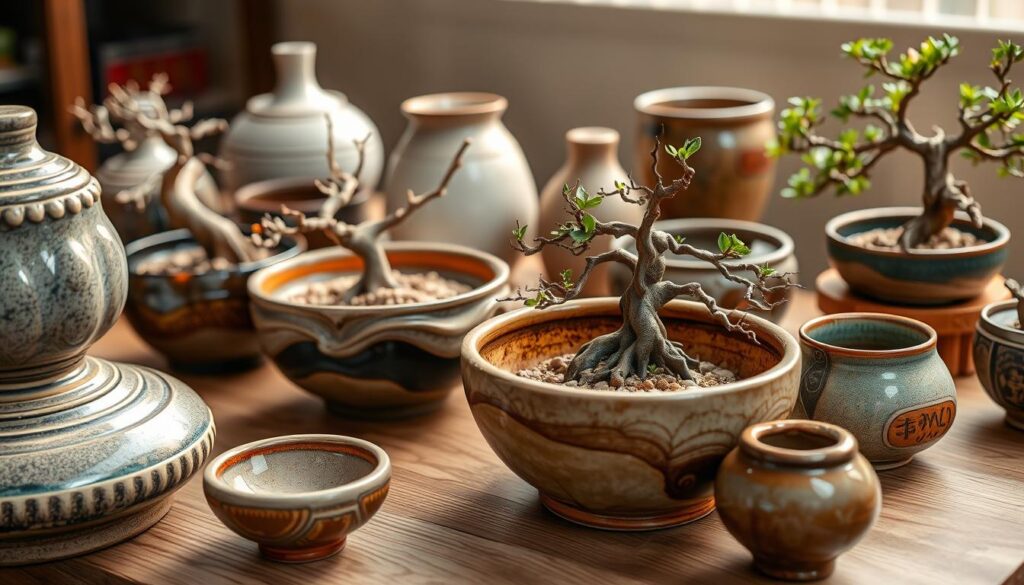
“The choice of bonsai pot can make all the difference in the development and overall aesthetic of your miniature trees. Carefully selecting the right material is a crucial step in mastering the art of bonsai.”
Seasonal Considerations for Bonsai Pots
Bonsai lovers know how much seasons affect our trees. Choosing the right pot is key for our trees’ health all year. It’s important to pick pots that meet winter and summer needs.
Winter Protection Strategies
In winter, bonsai trees need extra care. Look for frost-hardy pots to protect them from cold. Pots made of stoneware or high-fired materials are good choices.
You might also need to cover or move your bonsai. This could be to a greenhouse or a sheltered area. It helps keep them safe from harsh weather.
Summer Heat Management
Summer’s heat is another challenge for bonsai trees. For warm weather, choose pots that keep soil cool and let air in. Porous ceramic or terracotta pots are good for this.
These pots help prevent soil from getting too dry. But, they might need more water to keep the soil right. This keeps your bonsai healthy and strong, even when it’s hot.
By picking the right pots for each season, your bonsai can stay healthy and grow well. Keeping up with bonsai care and maintenance all year is crucial for your bonsai’s success.
“Proper pot selection is the foundation for a thriving bonsai. By understanding the unique needs of our trees, we can create an environment that allows them to flourish in every season.”
Specialty Pots for Different Bonsai Species
Choosing the right pot is key for bonsai trees. Each species has its own needs. The right bonsai containers can greatly affect growth and look.
Cascade-style bonsai need deeper pots for balance. Azaleas do well in terra-cotta pots, especially when bare-rooted. This allows for good air around the roots.
Pines often start in colander pots to help roots grow. Later, they move to terra-cotta or traditional pots. This meets their needs at different growth stages.
| Bonsai Species | Recommended Pot Type |
|---|---|
| Cascade-style bonsai | Deeper pots for balance and stability |
| Azaleas | Terra-cotta pots when bare-rooted |
| Pines | Colander-style pots for root development, then terra-cotta or bonsai pots |
Understanding each bonsai’s needs is vital for their health and beauty. Choosing the right pots is a key part of bonsai care.
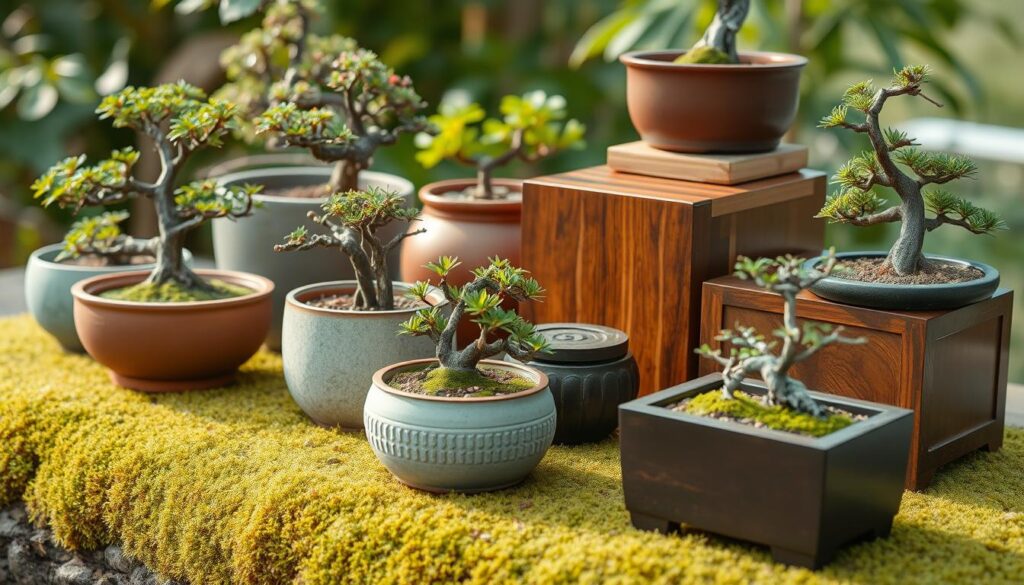
“The choice of bonsai pot can make or break the overall appearance and health of the tree. Paying close attention to species-specific requirements is essential for optimal growth and a visually stunning bonsai display.”
Maintenance and Care of Bonsai Pots
Keeping your bonsai trees healthy means taking good care of their pots. Cleaning and preventing damage are key to keeping your pots in great shape. This helps your trees grow well. Learn the best ways for bonsai pot care and maintenance.
Cleaning Techniques
Cleaning your bonsai pots is vital for your trees’ health. Use a soft brush and mild soap to remove dirt and minerals. Make sure to rinse well to avoid soap harming the soil or roots.
Prevention of Damage
Bonsai pots are fragile and can break if mishandled. When moving or repotting, hold them carefully to avoid damage. Also, protect outdoor pots from too much sun, rain, or cold to prevent cracks.
Check your pots often for signs of wear or damage. Look for cracks or chips that could harm the pot’s structure or drainage. Fix any issues quickly to keep your bonsai trees healthy.
“Proper maintenance and care of bonsai pots is crucial for the long-term success of your bonsai trees. By following these simple techniques, you can ensure your pots remain in excellent condition, supporting the growth and development of your beloved bonsai specimens.”
Professional Tips for Pot Selection
Choosing the right bonsai pot is key. In the early stages, experts might pick cheaper or bigger pots. But as the tree grows, they switch to better pots that match the tree’s look.
Experts use wood boxes for trees that need to grow. This method helps the tree fit better and grow stronger. They also try different pot styles to find the best look for each bonsai.
For bonsai pot selection, unglazed earthenware pots are great. They let the roots breathe and drain well. Glazed pots are good for trees that bloom or bear fruit. The glaze colors should match the tree’s colors.
- Prefer inexpensive or slightly oversized pots for trees in early refinement stages.
- Use wood boxes for custom sizing, especially for deciduous species or trees needing to regain vigor.
- Experiment with different pot styles to find the perfect match for each bonsai.
- Opt for unglazed earthenware pots for excellent drainage and root aeration.
- Choose glazed pots for flowering or fruiting trees, with colors that complement the tree’s natural hues.
“The right pot can make all the difference in the growth and development of a bonsai tree.”
By following these tips, bonsai lovers can pick the best pots. This helps their trees grow well and look their best.
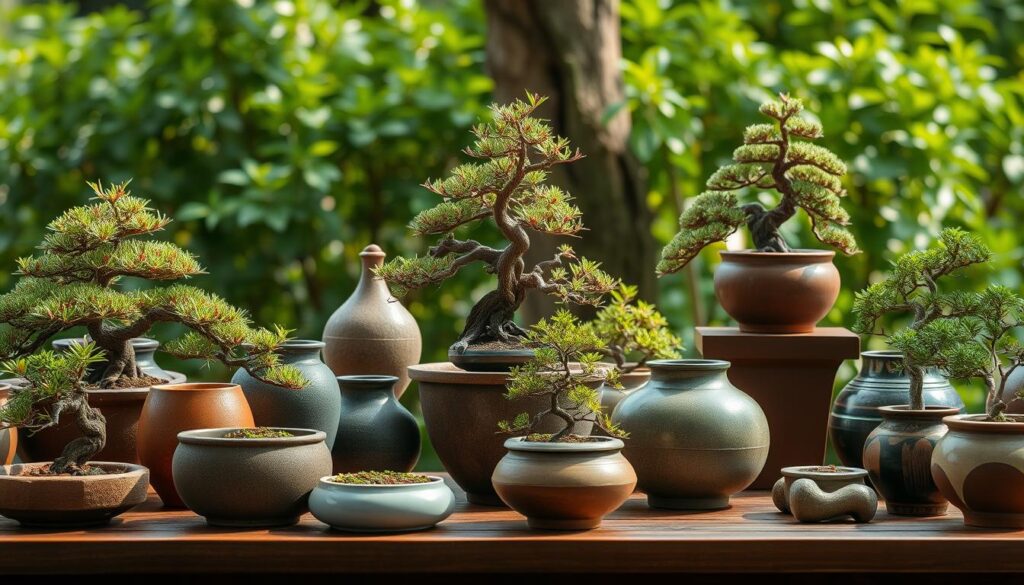
Common Mistakes to Avoid in Pot Selection
Choosing the right pot for your bonsai is key. Avoid pots that are too small, as they can limit root growth. Also, never pick pots without drainage holes to prevent waterlogging and root rot.
Outdoor bonsai lovers in cold areas should watch out for non-frost-hardy pots. These can crack and harm your tree in winter. Make sure the pot style fits your bonsai’s character for a better look and balance.
Don’t overlook the importance of pot weight for tree stability. Light pots can make your bonsai unstable, risking it to fall or get uprooted. Also, avoid deep pots to avoid overwatering and stunted root growth. By avoiding these mistakes, you can keep your bonsai pot care in top shape.
